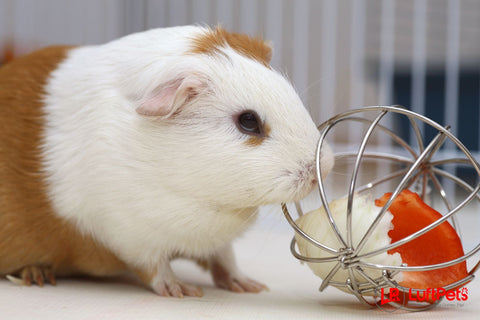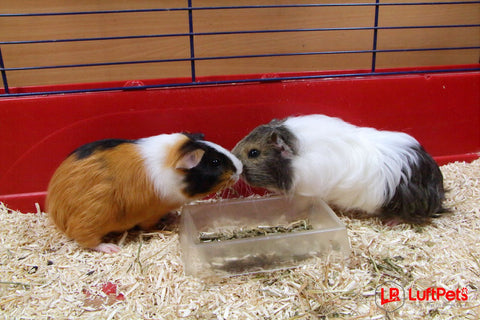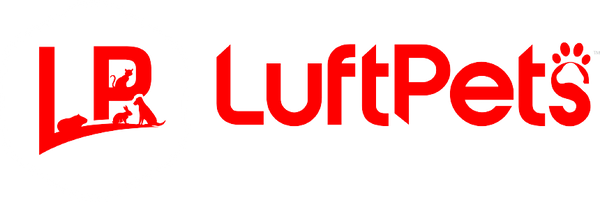Are you in search of the perfect setup for your guinea pig cage? Look no further!
Through extensive research - both as a vet and guinea lover - I've learned that size, layout, bedding, and cage placement play crucial roles in a guinea pig's health and happiness.
In this post, I'll share my insights and guide you through creating a cage setup that ensures your guinea pig thrives - plus 7 steps you need to know about to create a cage your guinea will love!
So, keep scrolling to discover my insider secrets and create the ultimate guinea paradise!
Key Takeaways
- Learn how to create a guinea cage that not only meets your pet’s basic needs but also enhances their overall health and happiness.
- Discover the importance of cage placement and how temperature, noise levels, and surrounding activities can impact your guinea pig's well-being.
- Uncover additional considerations like bedding, hideaways, and toys that can significantly improve your guinea pig's quality of life.
Creating the Ideal Guinea Pig Cage Setup: A Seven-Step Guide
To create the ideal guinea cage, prioritize a proper-sized enclosure (at least 7.5 sq ft for a single guinea pig), create an enriching environment with toys and ramps, and encourage vertical exploration.
For flooring considerations, learn about what is the best thing to put on the bottom of a small pet cage to ensure both comfort and hygiene. Further, prioritize health and adapt the setup to meet the guinea pig's specific needs.
Let's explore these 7 steps in more detail...
#1 Prioritize Size
Your guinea pig's cage should be spacious enough to cater to its active nature.

The vet team at Twin Rivers Veterinary Clinic, famous for curating self-help pet articles, writes, "The ideal cage provides plenty of room for your pet to move and explore, yet is safe and secure. [1]"
In support of this, a single guinea pig requires a minimum of 7.5 square feet, but remember - the larger, the better! If you're housing multiple guinea pigs, opt for an even larger enclosure (just to be safe!).
#2 Create an Enriching Environment
A guinea's habitat should be more than just a cage.
Fill it with challenges, hideaways, and ramps that promote physical activity and mental engagement [2].

#3 Encourage Vertical Exploration
Who said exploration has to be one-dimensional? Consider incorporating a multi-storied cage into your setup.
This addition offers vertical space for added movement, opening up a new world of exploration for your little pet.
#4 Keep Health Front and Center
A well-thought-out cage setup does more than just keep your guinea entertained; it contributes significantly to its overall health.
An engaging environment enhances their physical activity, preventing boredom and fostering well-being.
#5 Be Adaptive and Responsive
Lastly, adjust and adapt your setup based on your guinea's unique needs and preferences.
After all, every guinea is distinct, and personalizing their space can greatly enhance their comfort and happiness.
Follow these five steps, and you're on your way to creating an ideal habitat that caters to your guinea's every need!
#6 Choose the Right Water Bowl and Food Dish
The correct choice for guinea pigs isn't just about the food they eat; it's also about how it's presented.
So, select sturdy, chew-resistant water bowls and food dishes that can't be easily tipped over. Also, fresh water is crucial, so ensure your furry friend's water bowl is always filled and clean.
#7 Monitor Health Issues
Guinea pig owners need to be vigilant about their pets' health.
In fact, changes in behavior, appetite, or activity levels could indicate health issues.
Also, remember to check your pet and take them for veterinary check-ups regularly. After all, a well-maintained cage setup helps prevent many health problems.
Here's a quick summary of it all:
| Step | Description |
|---|---|
| 1. Prioritize Size | Guinea cages should be spacious to cater to its active nature. |
| 2. Create an Enriching Environment | Fill the cage with challenges, hideaways, and ramps to promote physical activity and mental engagement. |
| 3. Encourage Vertical Exploration | Incorporate a multi-storied cage to provide vertical space for added movement and exploration. |
| 4. Keep Health Front and Center | A well-thought-out cage setup contributes to the guinea pig's overall health by enhancing physical activity and preventing boredom. |
| 5. Be Adaptive and Responsive | Adjust and adapt the cage setup based on the guinea pig's unique needs and preferences for enhanced comfort and happiness. |
| 6. Choose the Right Water Bowl and Food Dish | Select sturdy, chew-resistant water bowls and food dishes that can't be easily tipped over, and ensure fresh and clean water. |
| 7. Monitor Health Issues | Be vigilant about changes in behavior, appetite, or activity levels, and schedule regular veterinary check-ups for the guinea pig's health monitoring. |
Now, of course, guinea placement can be a hassle. Not anymore (keep scrolling!)...
Guinea Pig Cage Placement (4 Tips)
A proper setup is a great start, but there's more you need to absorb... Considering the base of your enclosure, waterproof cage liners for guinea pigs can be an excellent choice for maintaining cleanliness and dryness.
To ensure that the cage setup is respected, ensure that the location is quiet, temperature-controlled, and secure.

Here are 4 tips to ensure your setup meets their needs...
#1 Ensure the Right Temperature
The ideal temperature for guinea pigs ranges from 65 to 75 degrees Fahrenheit, so avoid placing the cage near windows where it could receive direct sunlight or near drafts that could chill the cage.
#2 Maintain Peace
Given that guinea pigs can be easily startled by loud sounds, it's best to steer clear of high-traffic or noisy areas in your home.
#3 Avoid Noise & Traffic
Avoid high-traffic or noisy areas; guineas are easily startled by loud noises.
The best locations are quiet, temperature-controlled, and secure, like living rooms or bedrooms away from speakers or TVs.
#4 Keep Them Socializing
Keep the cage in an area where your guinea pig can observe and interact with you and your family, as socialization is crucial to their happiness.
Ideally, the cage should be in a quiet, temperature-controlled area that provides a secure environment.
Thanks to their minimal noise levels, living rooms or quiet bedrooms can work well. Also, these living areas have moderate temperatures and will be great for any guinea party.
And, of course, guinea pigs are social animals.
Even though they need a serene environment, it's crucial they are still part of the household activity. The cage's location should be somewhere your pet can see and interact with you and your family.
Envious of those perfect cages? Delve into these tips and envy no more!
Now head over to the next section, and learn a thing or 2!
Other Things to Consider
Besides the size and location of the cage, it's essential to consider the type of guinea pig cage bedding used, as it can affect your guinea's health.
Opt for high-absorbency, fast-drying, non-toxic materials, which are easier to clean and safer for your pet.
To elaborate, including hideaways and tunnels in the cage mimics the guinea's natural behavior of hiding and burrowing.
Place their food in different spots around the cage to encourage activity and exploration.
Expanding Your Guinea Pig's Toy Collection
Toys are pivotal in your guinea pig's mental and physical health.
To keep your guinea happy (and sound!), ensure a range of toys that include chew options for dental health, and engaging toys like tunnels and balls.

Maintain their interest by rotating their toys regularly and providing new stimuli. Always keep safety your top priority - all toys should be non-toxic and safe for use.
Social Interaction and Diet
Guineas thrive on social interactions. Be it companionship from another guinea or regular human contact, social interaction significantly contributes to their overall happiness.
A well-balanced diet forms the foundation of your guinea pig's health. Ensure they get fresh fruits, vegetables, and premium guinea pig pellets regularly.
I've saved the best for last! Check out these frequently asked questions for some zesty tips...
FAQs
1. What size should a guinea pig cage be?
A guinea pig cage should be at least 7.5 square feet for one guinea pig and larger for multiple pets. More space allows for better activity and stimulation.
2. Where should I place my guinea pig's cage?
The cage should be placed in a quiet, temperature-controlled area, away from direct sunlight and drafts. Locations such as living rooms or bedrooms are typically suitable.
3. What kind of toys should I get for my guinea pig?
A variety of toys, from chew toys for dental health to activity toys like tunnels and balls, are great for guinea pigs. Make sure all toys are safe and non-toxic.
Conclusion
Creating the best guinea pig cage setup entails considering factors beyond just a cage—it involves understanding the needs of your pet and crafting a living environment that caters to these needs.
By ensuring the cage is large enough, placed correctly, filled with the right bedding, and equipped with various toys, you can create a setup that guarantees your guinea pig's happiness and health.
Now, I'm eager to hear about you.
Share your tips and tricks with me in the comments section - or say hi!
Until next time...
Resources
1. March Newsletter: Care Tips for Your Pocket Pets [Internet]. www.twinriversvetclinic.com. [cited 2023 Jul 5]. Available from: https://www.twinriversvetclinic.com/articles/general/918134-march-newsletter-care-tips-for-your-pocket-pets
2. Is a pocket pet right for me? [Internet]. www.aaha.org. Available from: https://www.aaha.org/your-pet/pet-owner-education/ask-aaha/is-a-pocket-pet-right-for-you/


